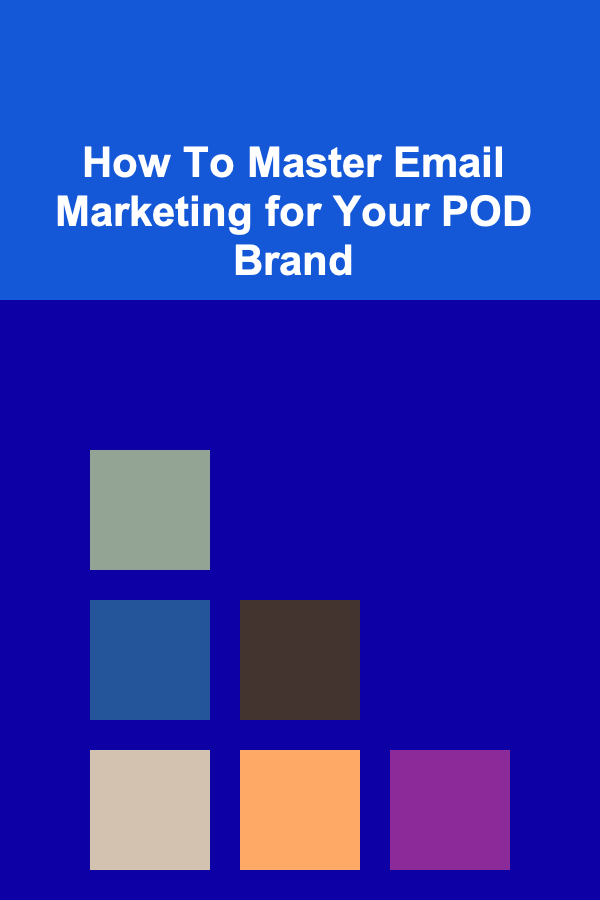
How To Master Email Marketing for Your POD Brand
ebook include PDF & Audio bundle (Micro Guide)
$12.99$8.99
Limited Time Offer! Order within the next:

Email marketing is one of the most powerful tools available to business owners, particularly those in the print-on-demand (POD) industry. With the growing competition in e-commerce, standing out in a crowded marketplace is more challenging than ever. However, mastering email marketing can help you build strong customer relationships, drive sales, and create a sustainable brand.
In this comprehensive guide, we'll explore how to effectively use email marketing to grow your POD brand, covering everything from building an email list to crafting compelling campaigns, and analyzing results. Whether you are just starting out or looking to refine your strategy, these steps will provide the insights needed to take your email marketing efforts to the next level.
Understanding Email Marketing for POD Brands
Before diving into the specifics of email marketing, it's crucial to understand why it's particularly effective for POD brands. Print-on-demand businesses typically have a unique advantage in that they offer customized products, which means there's an inherent personalization aspect that can resonate well with customers. Email marketing leverages this by allowing you to communicate directly with your customers and potential buyers, creating tailored experiences that drive engagement and sales.
Unlike traditional advertising, email marketing fosters a one-on-one relationship with your audience. When done correctly, it offers an unmatched level of personalization and a direct path to conversions.
Key Benefits of Email Marketing for POD Brands
- Direct Communication: Email allows you to reach your audience directly in their inbox, ensuring higher chances of visibility compared to social media posts.
- Automation Capabilities: With email marketing software, you can automate welcome emails, promotional campaigns, and follow-up sequences, saving you time and increasing efficiency.
- Customer Retention: Email marketing helps build lasting relationships with your customers, encouraging repeat purchases and brand loyalty.
- Higher ROI: According to studies, email marketing offers one of the highest returns on investment (ROI) in comparison to other marketing channels.
Building an Effective Email List
The first step in mastering email marketing for your POD brand is to build a solid email list. A high-quality email list forms the foundation for your marketing efforts. It's not just about gathering as many emails as possible, but focusing on gathering emails from individuals who are genuinely interested in your products.
Ways to Build Your Email List
2.1. Use Lead Magnets
A lead magnet is something of value that you offer to your visitors in exchange for their email address. For a POD brand, this could include:
- Discounts or Coupons: Offer a one-time discount in exchange for signing up for your newsletter.
- Freebies or Digital Downloads: Offer free design templates, eBooks, or guides that are relevant to your niche.
- Exclusive Content: Create valuable content, like "behind-the-scenes" access to how your designs are made, that will motivate customers to subscribe.
2.2. Pop-up Forms and Landing Pages
Utilizing pop-up forms on your website is an effective way to capture leads. You can also create dedicated landing pages for email sign-ups, especially when promoting a new product or launch.
2.3. Referral Programs
Encourage your existing customers to refer others to your brand in exchange for discounts or rewards. This method not only helps build your email list but also strengthens your relationship with existing customers.
2.4. Social Media Integration
Promote your email list on your social media platforms. You can create posts or ads that offer incentives for following your email list, driving followers to your sign-up page.
Maintaining Email List Health
It's important to regularly clean and maintain your email list. Over time, your list will accumulate inactive subscribers. Removing these users will help improve engagement rates and ensure that your messages are reaching individuals who truly care about your brand.
Crafting Compelling Emails
Now that you have a solid list, the next step is to send emails that actually get opened and acted upon. Crafting effective emails is an art that involves several key elements:
3.1. Personalization
Customers today expect personalized experiences. Use data from your email list (such as customer preferences or purchase history) to create tailored content. Personalizing emails with the recipient's name or offering product recommendations based on their past purchases is a simple but powerful way to engage.
3.2. Engaging Subject Lines
The subject line is the first thing a recipient sees, and it will determine whether they open your email. Keep subject lines clear, compelling, and relevant to the recipient's interests. A/B test different subject lines to see which ones drive better open rates.
Examples of Engaging Subject Lines:
- "Your Custom Design is Waiting! Grab 15% Off"
- "New Collection: Designed Just for You"
- "Thank You for Your Support -- Here's a Special Gift"
3.3. Clear and Compelling Copy
Once your recipient opens the email, make sure the copy is compelling. Focus on clear, concise language that communicates the value of your offer. Whether you're promoting a sale or introducing a new product, ensure that the email's purpose is obvious from the start.
3.4. Strong Calls to Action (CTAs)
Each email should have a clear CTA that guides the recipient on what to do next. Whether it's "Shop Now," "Get Your Discount," or "See New Designs," ensure that the CTA is action-oriented and easy to find.
3.5. Mobile Optimization
More people access emails through their mobile devices than ever before. Ensure that your emails are mobile-friendly, with clear formatting, clickable buttons, and images that render correctly across different devices.
Email Campaign Types for POD Brands
To keep your email marketing strategy diverse and engaging, you should use a mix of different email types. Here are some effective email campaigns for POD brands:
4.1. Welcome Emails
The first impression is crucial, so make your welcome email count. Thank new subscribers for joining your list, introduce them to your brand, and offer a special discount or promotion as a way to get them started on their buying journey.
4.2. Promotional Emails
Promotional emails are the bread and butter of most email campaigns. Use them to alert your subscribers about new products, sales, or seasonal promotions. Ensure your emails are visually appealing and highlight the most important details like discounts or special offers.
4.3. Abandoned Cart Emails
Abandoned cart emails are an effective way to recover potentially lost sales. When a customer adds products to their cart but doesn't complete the purchase, send a reminder email. You can even offer a discount or free shipping to entice them to finalize their purchase.
4.4. Product Recommendations
Based on past purchases or browsing behavior, send personalized product recommendations to your subscribers. This will increase the likelihood of additional purchases and help build customer loyalty.
4.5. Loyalty Program Emails
If you have a customer loyalty program, use email to communicate the benefits of joining. Send rewards, points, or exclusive offers to keep customers engaged and returning to your brand.
4.6. Seasonal Campaigns
Leverage holidays and seasonal events (like Christmas, Black Friday, etc.) to run special promotions. Tailor your messaging around the season and encourage subscribers to purchase customized gifts or products.
Automation: The Secret to Scaling
One of the key advantages of email marketing is automation. With automation, you can set up workflows that run in the background, saving you time and ensuring consistent communication with your customers.
5.1. Email Sequences
Create automated email sequences for different customer actions. For example:
- Welcome Series: A series of emails that introduce your brand and encourage first-time purchases.
- Abandoned Cart Recovery: A series of emails that are triggered when a customer leaves items in their cart.
- Post-Purchase Follow-Up: A thank-you email followed by a request for a review or product feedback.
5.2. Segmentation
Segmenting your email list based on customer behavior, demographics, or past purchases allows you to send highly relevant emails. This results in higher engagement rates and more conversions.
Analyzing and Optimizing Email Campaigns
To truly master email marketing for your POD brand, it's essential to constantly analyze and optimize your campaigns. Email marketing platforms provide in-depth analytics, so you can track key performance metrics like open rates, click-through rates, conversions, and unsubscribe rates.
6.1. A/B Testing
Regularly test different elements of your emails to see what works best. A/B test subject lines, CTAs, images, and copy to optimize your campaigns for better results.
6.2. Track KPIs
Key performance indicators (KPIs) like open rates, click-through rates (CTR), and conversion rates will help you measure the success of your campaigns. Track these metrics over time to identify trends and areas for improvement.
6.3. Feedback Loops
Encourage feedback from your subscribers to improve your email content. Use surveys or direct questions to gauge what they like, what they don't, and what they want to see more of in future emails.
Conclusion
Email marketing is a cornerstone of building a successful POD brand. By creating a strategy that focuses on building a quality email list, crafting personalized and compelling emails, automating your workflows, and continuously analyzing your results, you'll be well on your way to mastering email marketing.
Remember that email marketing is an ongoing process, and success comes with time, testing, and refinement. Keep your audience at the center of your efforts, and always look for new ways to engage, educate, and inspire your customers. With dedication and the right approach, your POD brand can thrive through the power of email marketing.
Reading More From Our Other Websites
- [Personal Care Tips 101] How to Balance Cardio and Strength Training for Fat Loss
- [Whitewater Rafting Tip 101] Epic Rafting Stories: Real Tales of Triumph, Survival, and Unforgettable Rapids
- [Organization Tip 101] How to Keep Your Garage Floor Clean and Organized
- [Home Space Saving 101] How to Create a Home Gym Without Taking Up a Lot of Space
- [Personal Care Tips 101] How to Use Soap to Get Rid of Stubborn Skin Blemishes
- [Organization Tip 101] How to Implement a Seasonal Drawer Organization Strategy
- [Organization Tip 101] How to Use Memory Boxes for Physical Photo Storage
- [Home Security 101] How to Use Landscaping to Boost Your Home's Security
- [Organization Tip 101] How to Use Folding Tables for Temporary Tool Storage
- [Personal Care Tips 101] How to Use Mascara to Make Your Eyes Look Bigger

How to Plan for Retirement in Your 30s and 40s
Read More
How to Stage a Home on a Budget Without Sacrificing Style
Read More
How To Use Containerization with Docker
Read More
10 Tips for Promoting Your Music on TikTok
Read More
How to Use a Flight Travel Checklist for Solo Female Travelers
Read More
How to Turn Your Travel Bucket List into a Timeline
Read MoreOther Products

How to Plan for Retirement in Your 30s and 40s
Read More
How to Stage a Home on a Budget Without Sacrificing Style
Read More
How To Use Containerization with Docker
Read More
10 Tips for Promoting Your Music on TikTok
Read More
How to Use a Flight Travel Checklist for Solo Female Travelers
Read More